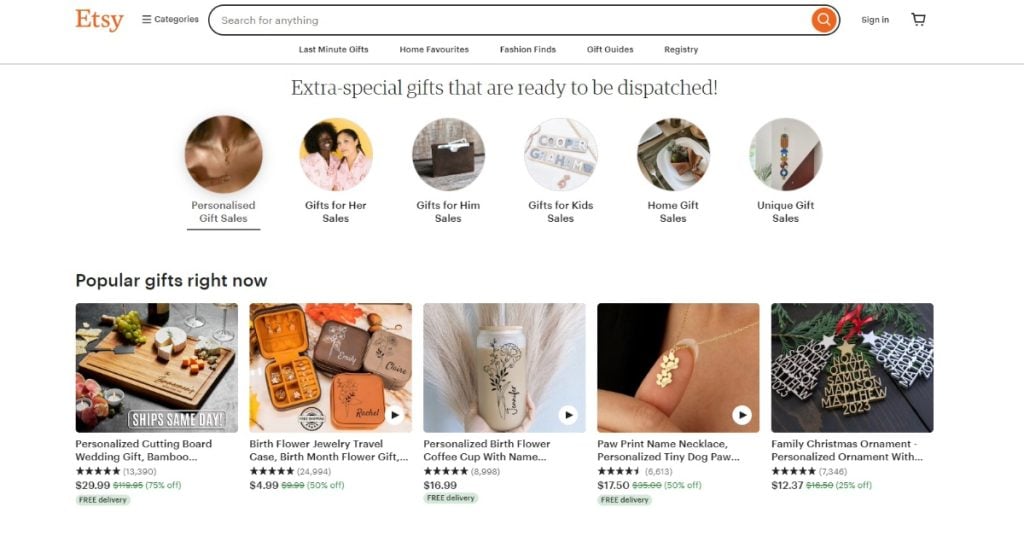
Etsy marketplace case study: book a demo to start yours
Etsy, as an online marketplace, focuses on handmade, vintage, and unique craft items and supplies from artisan makers. If you’d like to start your own marketplace like Etsy, you’re facing a buy vs build decision. So before you decide to build it in-house on top of Spree open-source, consider using the feature-rich Enterprise Edition cutting your time-to-market to a few weeks.
Build vs Buy a marketplace?
Employing open-source technology has its perks, including outright ownership and developmental flexibility, but these come at a substantial price. The journey to build a complete marketplace solution is lengthy and financially demanding, often stretching over months or years. This knowledge comes from our involvement in numerous marketplace projects.
Accelerating your launch and reducing development risks is best achieved with a proven, enterprise-grade platform like Spree Commerce Enterprise Edition—recommended by experts who understand how quickly custom marketplace projects can become delayed and costly.
Back to the Etsy marketplace case study
Etsy, an American e-commerce company established in 2005, is a unique player in the online marketplace arena. Unlike larger platforms like Amazon, Etsy focuses on handcrafted and vintage items, catering to independent artists and crafters.
With a seller pool predominantly comprising females (over 80%), Etsy offers a diverse range of products from toys and art to antique furniture and jewelry. The platform enables sellers to create, manage, and sell their goods, standing out for its niche market appeal.
Creating a store on Etsy is free, but sellers incur fees for listing ($0.20 per item), selling, and delivering orders. Etsy’s commission is 5% of the sale price, reduced for those accepting Etsy Payments. This fee structure is part of Etsy’s strategy to balance accessibility for sellers with revenue generation.
Financially, Etsy faced challenges in early 2023. The first quarter saw a 4.6% decrease in Gross Merchandise Sales (GMS) to $3.1 billion, attributed to shifts in consumer spending patterns and reduced spending in key categories. Despite this, Etsy reported a 10.6% increase in revenue to $640.9 million, though net income fell by 13.4% to $74.5 million. The platform’s active buyer base grew slightly, indicating its continued appeal despite economic headwinds.
Etsy’s focus on unique, handcrafted, and vintage items keeps it distinct in the e-commerce landscape, attracting a dedicated customer base. Its financial strategy and evolving marketplace model aim to sustain growth and relevance amidst the dynamic challenges of online retail.
How to emulate Etsy marketplace success?
To get success like Etsy, it’s advisable to initiate your marketplace in a matter of weeks, not months. Look into how your product catalog aligns with your target audience’s needs and adjust your customer acquisition approach based on real-life feedback.
It’s crucial to test the market before you fully invest in developing it.
Here’s how to get started:
- Book a marketplace demo call: We’ll help you evaluate Spree for your marketplace needs and get started with the Enterprise Edition
- Customize your Storefront: Use the drag & drop page builder or custom CSS
- Onboard Brands: Invite your brands or choose brands from our catalog
- Select Products: Curate products and collections manually or automate it
- Embed products: Make your content, newsletters, social media shoppable
- Get Paid: Get paid as soon as products are shipped by the brands
- End-to-end automation: brands sync, fulfillment, payouts, invoicing, taxes
When you’ve tried all that and it works, start thinking about building your own, custom-made marketplace project based on Spree Commerce. First, by decoupling the storefront and going headless with marketplace API, and later with your own backend, if you decide you really need it. Just lift and shift the storefront.
Nobody has to know what’s under the hood, right?



